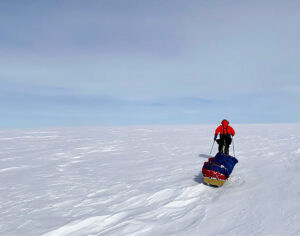Most expeditions are now out on the ice. It’s been a tough start, with skiers getting their first taste of sastrugi and whiteouts. One solo skier is already carrying an injury and a couple of unsupported expeditions will need to pick up their pace if they want to avoid an eventual resupply.
Crossings
Gareth Andrews and Richard Stephenson
Their second week has started well. Day 8 on the ice was their most productive so far, 20km in very poor visibility. Day 9, another whiteout, drew another solid 20km. The duo has been incrementally ramping up their ski time and are now clocking close to nine hours per day. The combination of more time on the ice and settling into an expedition routine seems to be paying dividends. Their most recent update shows 21.5km covered on day 10.
Preet Chandi
Preet Chandi’s ski routine involves one hour of exertion followed by a 10-minute break. Her evenings are spent getting the tent up and completing the small yet crucial bits of Antarctic admin: melting snow, making dinner, checking gear, etc.
Like Andrews and Stephenson, Chandi has experienced some early whiteouts. She spent days 5 and 6 staring at her compass mount. Most afternoons, the haze transitioned to low cloud, granting some respite.

Chandi has spent more time than she’d like staring at her compass mount. Photo: Preet Chandi
After a few days of slightly better visibility, day 10 was again skiing inside a ping-pong ball. Chandi sounded a little deflated by the tough start in her latest audio log.
“It’s been a pretty tough ten days so far. I’m moving slowly with my heavy pulk. Fell a few times today during the whiteout, no injuries,” she said.
Chandi has completed 151km of her 1,600km solo crossing.
Six-person Australian team
After a longer-than-expected wait in Punta Arenas, the Australian team is now six days into their Hercules Inlet-South Pole-Ross Ice Shelf expedition.
They set out from Hercules Inlet four days after Preet Chandi and reported the same early difficulties: the start of small sastrugi on day 3 and whiteout conditions on day 6.
It’s been a slow start. They have completed 74km but should pick up the pace as they settle into a routine.
Hercules Inlet to the South Pole
A gaggle of South Pole skiers was also delayed in Punta Arenas, with most finally flying to Union Glacier on November 21, including Mikko Vermas and Tero Teelahti. There, the duo continues to wait for good weather to fly to Hercules Inlet. Solo skiers Hedvig Hjertaker and Young Mi Kim are waiting for the same flight.

Mateusz Waligora’s skis feature polar pioneer Fridtjof Nansen. Photo: Mateusz Waligora
Solo skiers Mateusz Waligora and Ben Weber dodged the wait in Chile. Both are now a week into their journeys. Waligora is not enjoying the sastrugi. He likened them to “skiing with your eyes closed on irregularly placed curbs tens of centimetres high”. On a strange side note, he also said: “I’ve yet to meet a polar bear. I’m so alert, you know, eyes around my head. They will not surprise me.” I’m going to assume he’s joking!
Weber has made a slow, painful start. By day 4, he was experiencing considerable neck and back pain, which he believes was brought on by “a combination of the extreme weight of the sled, overexertion and, worse than either of these, my harness not being adjusted correctly. The shoulder straps were too tight and the waist strap too loose, so much of the sled’s 135kg in weight was being transferred into my shoulders and neck.”

Ben Weber is already struggling with an injury. Photo: Ben Weber
On day 6, he took a rest day to recover. The time off did him some good, but it was only a temporary reprieve. After 15km, discomfort gave way to excruciating pain while he set up camp. After a call with his expedition manager, Weber has opted for another rest day and more medication tomorrow.
“Most important is for this to get better, then to get more distance out of the way,” he said. “I still have plenty of food and supplies so it should be all right.”
Cycling across Antarctica
Experienced long-distance cold-weather cyclist Omar Di Felice is due to set out on his 1,600km expedition. He hopes to cycle from Hercules Inlet to the South Pole, before joining the access road to the McMurdo research station.
Di Felice completed his safety briefing in Union Glacier yesterday and is hoping to fly to his starting point today.
It remains to be seen how much of the route he’ll be able to do from the saddle. Generating traction will be extremely difficult and he’ll likely have to do a lot of pushing, at least until the access road.
Guided groups from the Messner Start
The Ousland Explorers team arrived eight days ago and is three days in. Spirits are high as they ease into long days on the ice. Their routine is similar to Preet Chandi’s, 50 minutes of skiing followed by a 10-minute break, repeated throughout the day.
Once safely in their tents, the Norwegians are “working hard at acclimatizing the New Zealanders to the smell of cod.” I imagine the Kiwis are clamoring for longer days on the ice.
The 10-person “Inspire 22” team guided by Canadian Devon McDiarmid, has landed in Antarctica but is yet to begin their journey.





